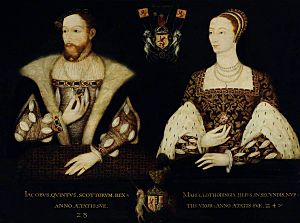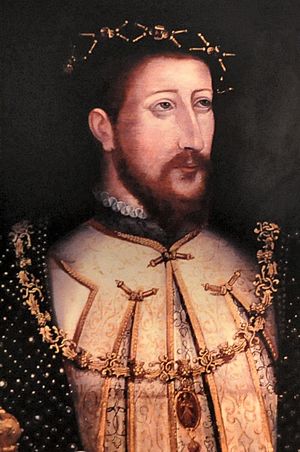Jewels of James V of Scotland facts for kids
King James V of Scotland lived a long time ago, from 1512 to 1542. He was known for his amazing collection of jewellery and precious stones. We know a lot about his jewels because of old records. These records include lists of everything he owned and notes from his royal treasurer. James V used his dazzling jewels to show off his power and wealth. It was a way for him to look strong and important as a king.
Contents
What James V Inherited
James V's father was James IV of Scotland. James IV died in a big battle called the battle of Flodden in September 1513. We don't know much about the jewels James V inherited from his father. One special item was a gold cross. It had three red rubies and three blue sapphires. This cross was sent to Catherine of Aragon, who was a queen in England. It was later listed in the jewel book of Henry VIII and kept in the Tower of London.
King James V's Amazing Jewels
Old lists from 1542 tell us about James V's treasures. Many jewels were kept in a black velvet box. This box was in the Jewel House at Edinburgh Castle. Inside, there were many sparkling diamonds, five green emeralds, and eleven red rubies. There were also three blue sapphires and a ring shaped like a skull.
A steel box held 101 loose pearls. There were also two pieces of mother-of-pearl and about 20 smaller pearls. One special piece was an "ornament for a woman's breast." This was likely worn across the top of a dress. It had 22 groups of three pearls, linked by gold knots. James V also bought a large diamond and a big ruby from a man named Howesone. He had bracelets with rubies, which might have been used for his coronation.
The king also owned strung beads called Paternosters. Some of these beads smelled nice, like musk. Others were made of gold, garnet, or jasper. Some items had belonged to his first wife, Madeleine of Valois. There was even a piece of gold from Scottish mines. Some of his pearls might have been found in Scottish rivers.
Chains and Pendants
James V bought many gold chains. Some were decorated with colourful enamel and precious stones. One chain had diamonds, rubies, and pearls. He bought it to wear the symbol of the French Order of Saint Michael. He also wore gold chains with whistles. These might have been useful when he was on a ship. Pendants worn with chains were called "tablets." He had a diamond shaped like a fleur-de-lis (a French lily symbol). Another tablet had a picture of "Our Lady."
Bracelets and Rings
James V wore bracelets, and records show they were often repaired. He also had rosary beads made of agate and jasper. Some were gold beads filled with musk, which smelled good. His lists show he owned over 100 rings! His personal helper, Harry Kemp, looked after some of these rings. Harry also kept the king's gold combs and a toothpick, along with several velvet hats.
Jewelled Hats and Bonnets
James V loved to decorate his hats, called bonnets. He had special ornaments, or "ensigns," sewn onto them. These included two mermaid badges. One mermaid was made by a goldsmith from Edinburgh named John Mosman. These ensigns were also called "targets." His bonnets were also decorated with gold tags. These tags were known as aglets or horns.
In November 1542, the king's best bonnets were described in detail. Harry Kemp kept them. Here are some examples of how fancy they were:
- A velvet bonnet with a target and a woman's image. She held a diamond, and a large ruby was under her feet. This bonnet also had ten groups of jewels. Each group had four diamonds, a ruby, and a flat diamond. There were also 24 groups of pearls, with four pearls in each group. Plus, ten small gold thistles and a tiny chain on each side.
- Another velvet bonnet had a target with a large flat diamond. It also had ten plain diamonds in gold settings. There were 18 groups of pearls, with three pearls in each group. And nine long groups, with four pearls in each.
- A black velvet bonnet had a mermaid target. Her tail was made of diamonds. It also had a ruby and a flat diamond. There were six gold settings, each with a large ruby. And 12 settings, each with two large pearls.
The king also had woollen hats. These were decorated with targets and gold buttons. Some of his gold buttons had pearls. Others were shaped like acorns or peas in a pod. Three buttons even had women's faces! He bought many gold buttons and "horns" (aglets) from France. For example, he had 119 blue-enamelled buttons for a coat. He wore this coat when he entered Paris. At that time, he also had 23 gold thistles made for his bonnet. And 20 more for his gown. He bought a badge for his bonnet, described as an "image with a ruby." He also got a gold chain and 36 buttons to decorate the same bonnet.
Goldsmiths for the King
John Mosman was a goldsmith who made jewellery for the king. He also fixed items and sometimes changed them. For example, he turned gold rosary beads into buttons and special rings. Mosman even travelled to France to buy things for the king. Another person, Thomas Erskine of Halton, also went to France to buy jewels. James V himself went to France. There, he married Madeleine of France. He bought gold buttons with blue enamel and hundreds of pearls to sew onto his clothes.
Another goldsmith, Thomas Rynd, worked for the king from St Andrews. In May 1539, he provided gold buttons with enamel. He also made aglets or horns, a red-enamelled necklace, and a gold belt with white letters. He also made three rings. He sold a head-dress and a chain to Mary of Guise. She was the king's second wife. James V also bought small gold chains and "tablet" pendants from Rynd. These were gifts for the queen's ladies. Later in 1539, Rynd supplied a chain and a gold "target." He also fixed a gold cup and some gold buttons. He provided two pairs of tags or horns to fasten bracelets.
Final Lists of Jewels
Before King James V died in November 1542, a final list of his silver and jewels was made. This list was created by James Kirkcaldy of Grange and John Danielstoun. A clerk named Henry Wardlaw was paid for writing this "inventour buke."
Mary, Queen of Scots, was James V's daughter. She inherited many of her father's personal jewels. For a while, the Earl of Arran ruled Scotland as a regent (a temporary ruler). In 1556, Mary's mother, Mary of Guise, became regent. Arran then sent a collection of royal jewels to the young queen in France. Among these jewels was the special hat badge. It was made in Edinburgh by John Mosman. It was made from Scottish gold. This badge showed a mermaid with diamonds, holding a mirror and a ruby comb.
See also



